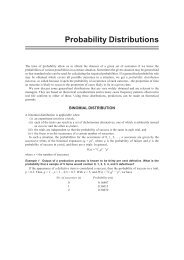International-Business-Dr-R-Chandran-E-book
International-Business-Dr-R-Chandran-E-book
International-Business-Dr-R-Chandran-E-book
You also want an ePaper? Increase the reach of your titles
YUMPU automatically turns print PDFs into web optimized ePapers that Google loves.
185<br />
<strong>International</strong> <strong>Business</strong>- <strong>Dr</strong>. R. <strong>Chandran</strong><br />
an examination. Once any objections raised are dealt with, the application<br />
can proceed to grant the patent. Once the patent has been granted, it remains<br />
in force for 20 years, subject to payment of annual renewal fees to keep the<br />
patent in force, and a granted patent provides a patentee with an absolute<br />
legal monopoly which can be used to prevent unauthorized use of the<br />
patented invention.<br />
Generally speaking, patents are territorial and it is necessary to obtain a<br />
patent in each country in which protection is required. A patent in a<br />
particular country does, however enable a patentee to prevent importation<br />
into that country of an infringing product from wherever that importation<br />
takes place. Therefore, it is common for patentees to protect their inventions<br />
in the countries which constitute either their major markets, or which contain<br />
their major competitors’ manufacturing sites. Whilst patents are essentially<br />
territorial, there are a number of international conventions that make the<br />
process of applying for international patent protection more simple and cost<br />
effective than filing a national patent application in all the countries of<br />
interest. The most important these international conventions are the<br />
European patent Convention and the patent Cooperation Treaty.<br />
Trademarks<br />
Traditionally trademarks were any word or logo that serves to designate the<br />
origin of goods or services. In recent years the law has come to recognize<br />
that there are many other ways of designating the origin of goods or<br />
services, e.g. advertising jingles, smells and the shape of goods or<br />
packaging. Nowadays, therefore, these are also recognized as trademarks.<br />
For registration, a trademark must be capable of distinguishing the<br />
goods or services of one party from those of other parties. Furthermore,<br />
trademarks that consist of anything other than words or logos must be<br />
capable of being represented graphically. Any sign that does not satisfy<br />
these requirements cannot be registered as a trademark. Signs which are<br />
inherently non – distinctive or descriptive or which consist of words or<br />
symbols, things that traders in the same area of business may wish<br />
legitimately to use to identify the origin of their gods may be excluded from<br />
registration. For example surnames and geographical locations would not be<br />
allowed as trademarks.<br />
In some countries, for example the United Kingdom, rights can be<br />
obtained on a trademark simply by using a symbol or sign extensively<br />
enough, so that it is identified with the product. In these circumstances, the<br />
person or company using the trademark has legal resources through an<br />
Only for Private Circulation





